Move Forward Together
- POMBILITI + OPFOLDA is the only therapy in LOPD studied in a head-to-head randomized controlled trial in predominantly ERT-experienced patients1-3
- ERT-experienced patients in the trial were treated on average >7 years with ERT prior to entering the PROPEL clinical trial3
- Walking ability and respiratory function were evaluated over 104 weeks4
- Demonstrated safety over 104 weeks4
Study Design and Baseline Characteristics
PROPEL: The first and only head-to-head, randomized, Phase 3 trial in LOPD with a majority ERT-experienced patient cohort1-3
Nearly 80% of the study population was ERT-experienced


- Primary endpoint: Change from baseline to Week 52 in 6-minute walk distance (6MWD) for comparison of superiority3‡
- Key secondary endpoint: Change from baseline to Week 52 in forced vital capacity (FVC)3
- POMBILITI in combination with OPFOLDA is not approved for use in ERT-naïve patients with LOPD. The ERT-naïve patient subgroup enrolled too few patients to conclusively interpret the data1,3
6MWD, 6-minute walk distance; ERT, enzyme replacement therapy; FVC, forced vital capacity; IV,
intravenous; LOPD, late-onset Pompe disease; QOW, every other week.
*After database lock, 1 ERT-naïve subject was found to have
intentionally underperformed at baseline. This subject was excluded from all 6MWD efficacy results;
this change did not alter the statistical outcomes of the study.5
†Dosage based on patient weight.2
‡Primary endpoint for superiority was not met.3
Select inclusion criteria1-3
- ≥18 years of age weighing ≥40 kg at screening
- Confirmed diagnosis of LOPD
- ERT-experienced adults were on either US-approved or non-US-approved alglucosidase alfa for ≥24 months
- Sitting percent-predicted FVC of ≥30% of the predicted value for healthy adults
- 6MWD of ≥75 meters at 2 screening tests
KEY EXCLUSION criteria1-3
- Received previous treatment with any investigational therapy or pharmacological treatment for Pompe disease, other than alglucosidase alfa, within 30 days, or 5 half-lives of the therapy, before Day 1 of the study, whichever was longer
- Received gene therapy for Pompe disease
- Use of ventilation support for more than 6 hours per day while awake
All ERT-experienced patients in the study had been treated for years3
Minimum treatment time for inclusion was 2 years


PROPEL: Results at 52 Weeks
ERT-experienced patients taking POMBILITI + OPFOLDA demonstrated measurable improvement in 6MWD and PP FVC vs comparator1,2§‖
 ERT-subgroup analysis: prespecified
ERT-subgroup analysis: prespecified
Improvement in 6-Minute Walk Distance (6MWD)1,2
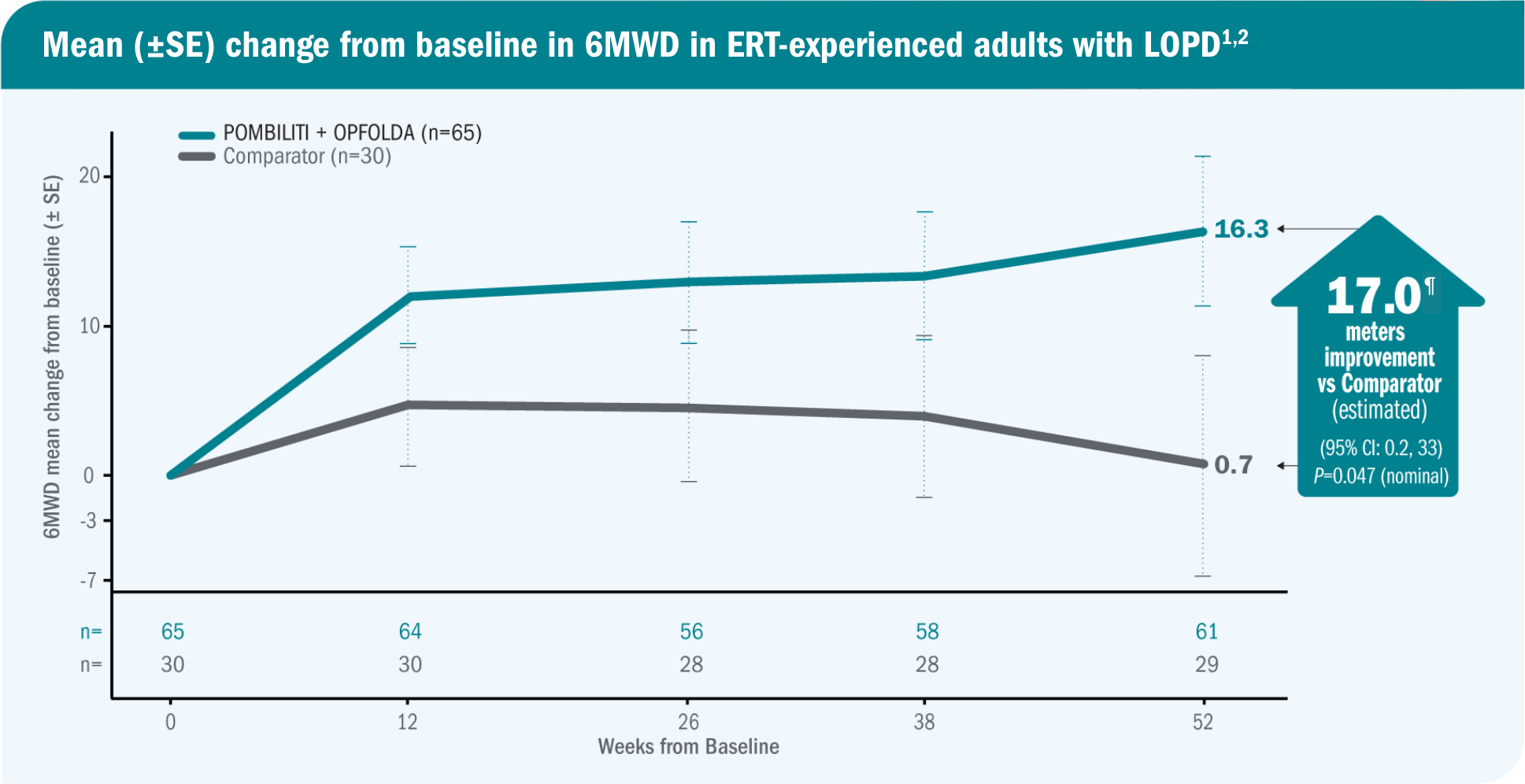
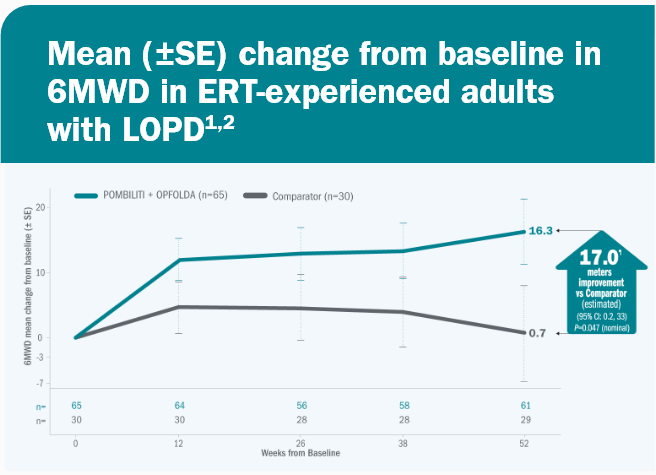
PP, percent predicted; SE, standard error.
§A US-approved alglucosidase alfa product was not used in
this
clinical trial. Conclusions cannot be drawn from this clinical trial regarding comparative
effectiveness between a US-approved alglucosidase alfa product and POMBILITI in combination with
OPFOLDA.1,2
‖Primary endpoint for superiority was not
met.3
¶For the ERT-experienced group, the treatment difference
of the mean
was estimated by nonparametric analysis of covariance that included treatment, gender, baseline
6MWD, age, weight, and height in the model. Missing data at Week 52 was imputed using last observed
values.1,2
 ERT-subgroup analysis: prespecified
ERT-subgroup analysis: prespecified
Improvement in Percent-Predicted (PP) Forced Vital Capacity (FVC)1,2
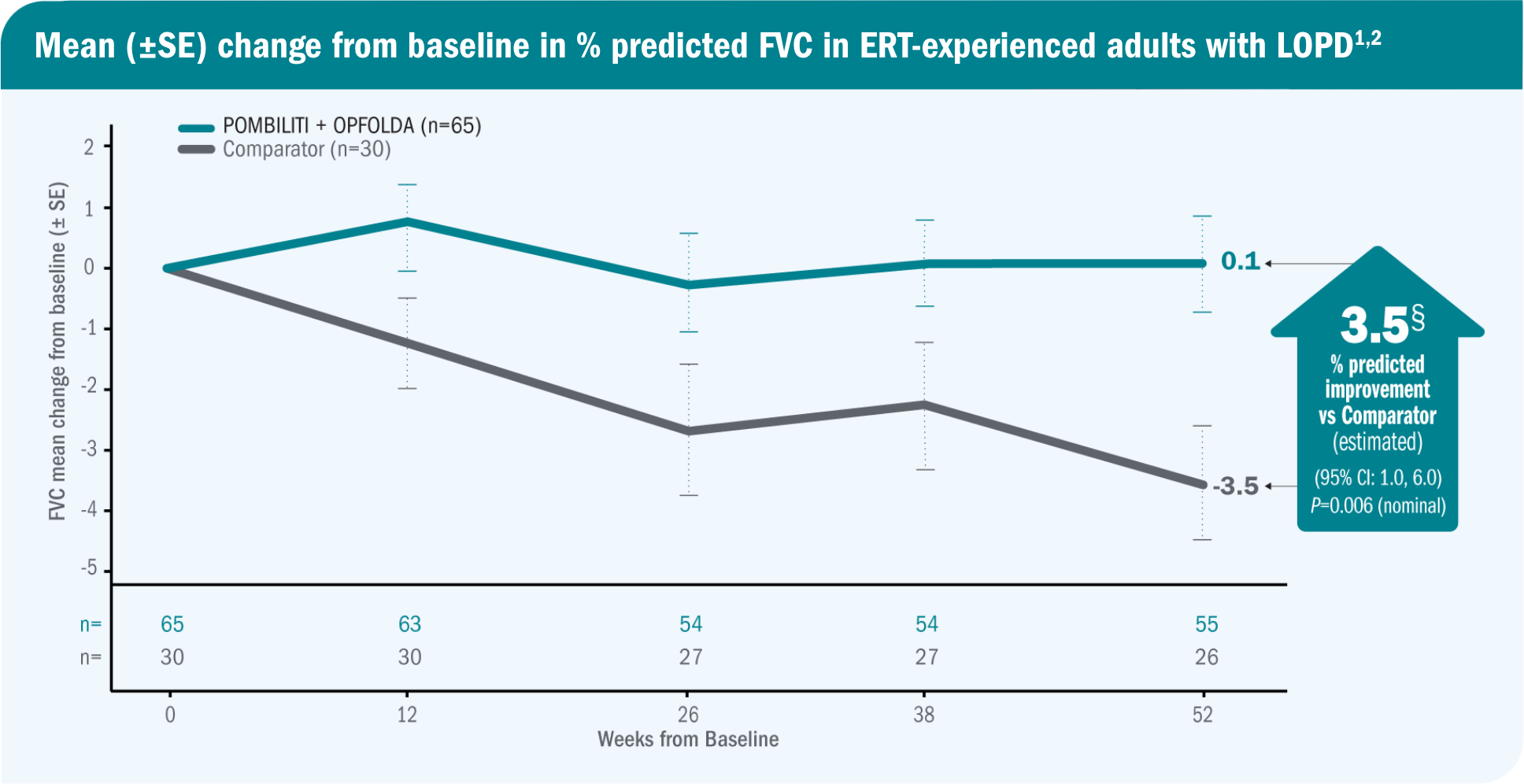
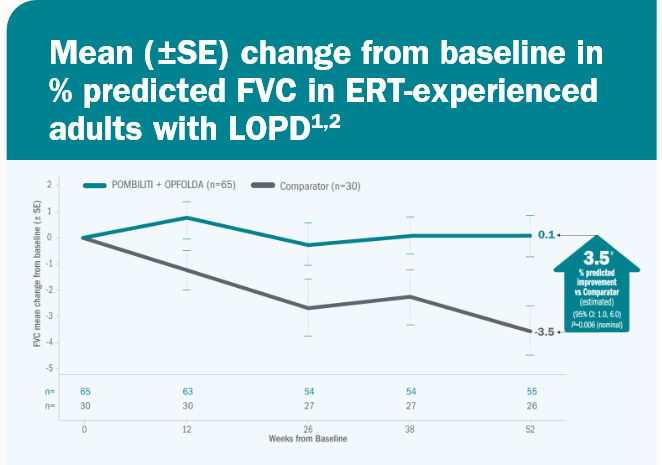
#For the ERT-experienced group, the treatment difference of the mean was estimated by analysis of covariance that included treatment, gender, baseline FVC, age, weight, and height in the model. Missing data at Week 52 was imputed using last observed values.1,2
 ERT-subgroup analysis: prespecified
ERT-subgroup analysis: prespecified
Improvement in Hex4 Biomarker1
ERT-experienced patients taking POMBILITI + OPFOLDA showed a reduction in Hex4 (a metabolite of excess glycogen in patients with LOPD), as measured by Glc4 concentration vs an increase with the Comparator.
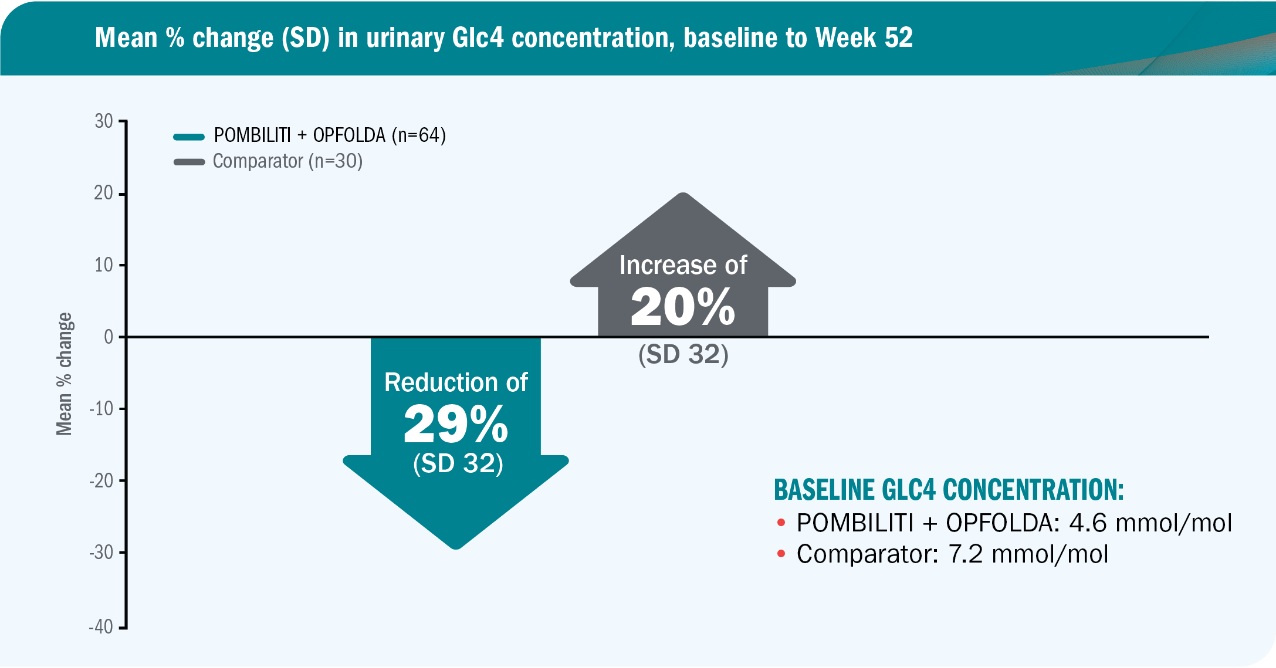
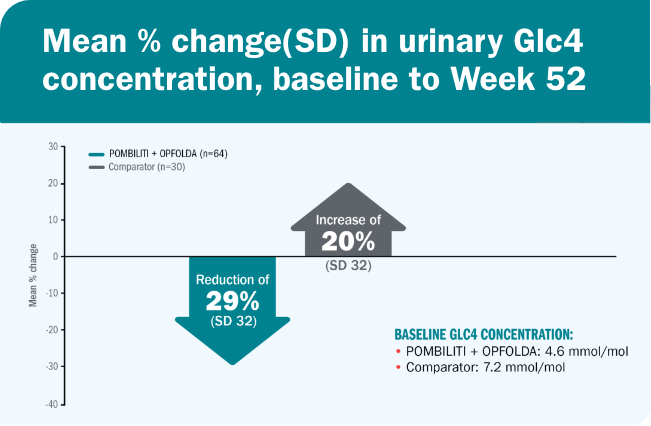
Glc4, glucosidase tetrasaccharide; Hex4, hexose tetrasaccharide.
PROPEL: Safety Profile at 52 Weeks
Demonstrated Safety in 151 Patients Across 3 Clinical Trials1,2


A total of 5 patients across 3 clinical trials PERMANENTLY DISCONTINUED POMBILITI + OPFOLDA due to adverse reactions (4/5 due to serious adverse reactions)1
Life-threatening hypersensitivity reactions, including anaphylaxis, have been reported in POMBILITI-treated patients1
- In clinical trials, 41 (27%) POMBILITI-treated patients experienced hypersensitivity reactions, including 4 (3%) reporting severe hypersensitivity reactions and 4 (3%) additional patients who experienced anaphylaxis1*
- Infusion-associated reactions were reported in 48 (32%) patients treated with POMBILITI + OPFOLDA across three clinical trials1
- There was no identified clinically significant effect of ADA on POMBILITI + OPFOLDA PK or PD over the treatment duration of 52 weeks in PROPEL. Due to the small number of patients with negative ADA, the effect of ADA on the effectiveness of POMBILITI + OPFOLDA is unknown1
ADA, antidrug antibodies; PD, pharmacodynamics; PK, pharmacokinetics.
*Fulfilling at least one of the Sampson criteria.1
Study Design
PROPEL Open-Label Extension (OLE): Interim analysis evaluating the long-term efficacy and safety of POMBILITI + OPFOLDA for an additional 52 weeks4
- After 52 weeks in the PROPEL study, 91 ERT-experienced patients and 28 ERT-naïve patients continued or crossed over to POMBILITI + OPFOLDA*†
- Patients in the OLE study received POMBILITI + OPFOLDA every 2 weeks, beginning 2 weeks after the last dose of the ERT that they received in the PROPEL study
- Baseline characteristics in PROPEL were representative of the LOPD population and generally similar between treatment groups


>90%
of patients who enrolled in the OLE remained through Week 1044¶
Select Endpoints4
- Motor function: 6MWD (% predicted)
- Respiratory function: FVC (sitting, % predicted)
- Biomarkers: Hex4 (mmol/mol) and CK (U/L)
CK, creatine kinase; GSGC, Gait, Stairs, Gowers’ maneuver, Chair; Hex4, hexose tetrasaccharide; MMT,
manual muscle test; OLE, open-label extension; PROMIS, Patient-Reported Outcomes Measurement
Information System.
*POMBILITI in combination with OPFOLDA is not approved for use in
ERT-naïve patients with LOPD. The ERT-naïve patient subgroup
in PROPEL enrolled too few patients to conclusively interpret the data.1,3
†ERT‑experienced patients are defined as those treated with ERT for
at least 2 years prior to their participation in the PROPEL study.3
‡Dosage based on patient weight.1,2
§A US-approved alglucosidase alfa product was not used in this
clinical trial. Conclusions cannot be drawn from this clinical trial
regarding comparative effectiveness between a US-approved alglucosidase alfa product and POMBILITI
in combination with OPFOLDA.1,2
‖Includes 1 patient who enrolled but was never
dosed.4
¶11 patients discontinued due to withdrawn consent, adverse events,
investigator decision, or because they were lost to follow-up.4
Important Study Limitations4
- The OLE was unblinded and had no control group
- This study includes data that are not in the FDA-approved Prescribing Informations for POMBILITI + OPFOLDA
- Data were analyzed descriptively, with no statistical comparisons. Therefore, no conclusions regarding treatment differences should be made as results could represent chance findings
- LOPD is a rare disease, so the sample size was relatively small
- Given the heterogeneous nature of LOPD, spanning a wide spectrum of manifestations, disease severity, rates of progression, and responses to treatment, tailoring the individualized treatment approaches to optimize patient outcomes will become more critical
- Creatine kinase (CK) is a nonspecific biomarker of muscle damage. The clinical relevancy of CK has not been established in LOPD6
OLE: Interim Analysis Through 104 Weeks
 ERT-subgroup analysis: prespecified from PROPEL
ERT-subgroup analysis: prespecified from PROPEL
Biomarker: Hex4 Levels
Hex4 is a metabolite of excess glycogen and is measured by Glc4 concentration1
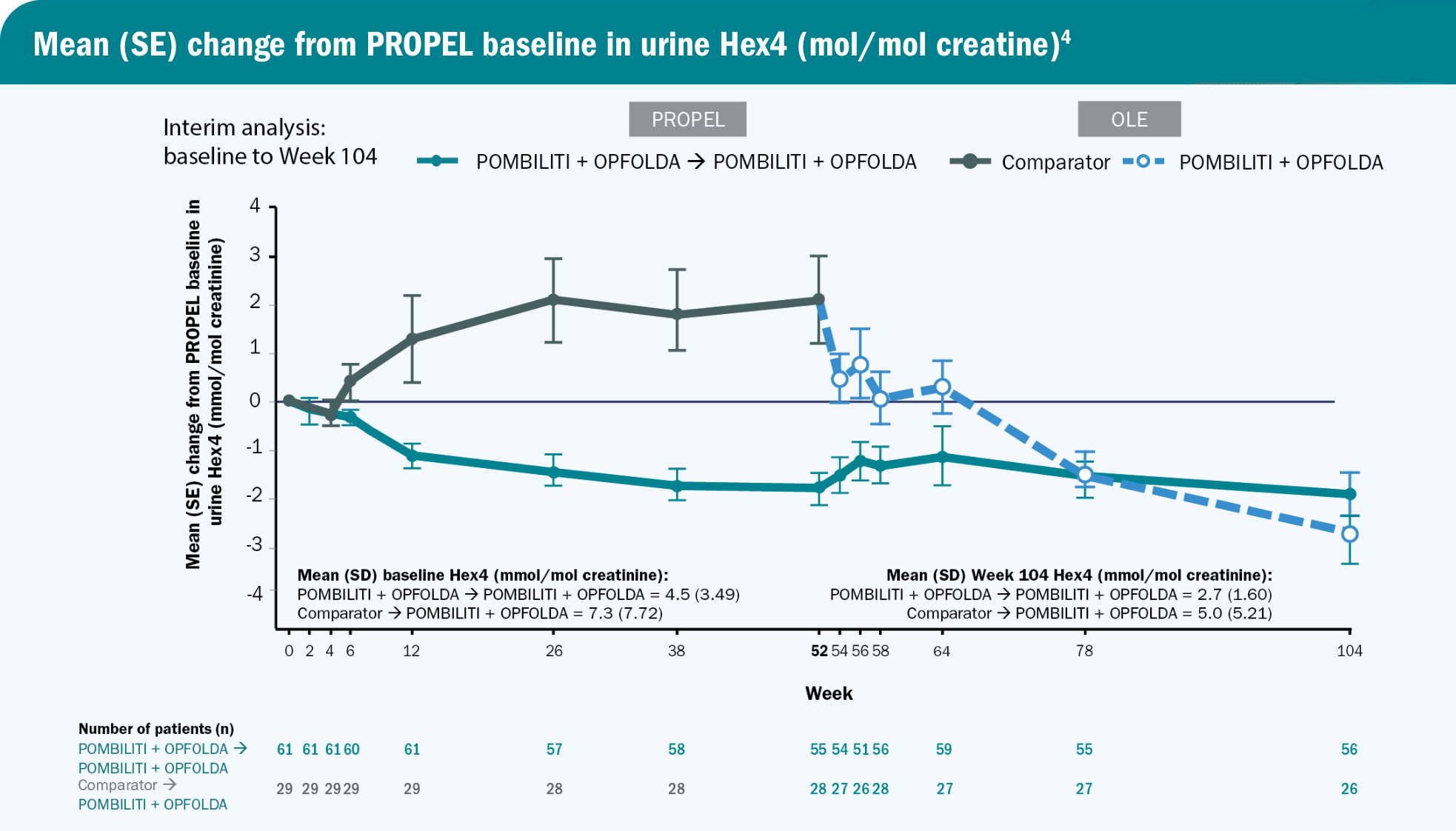
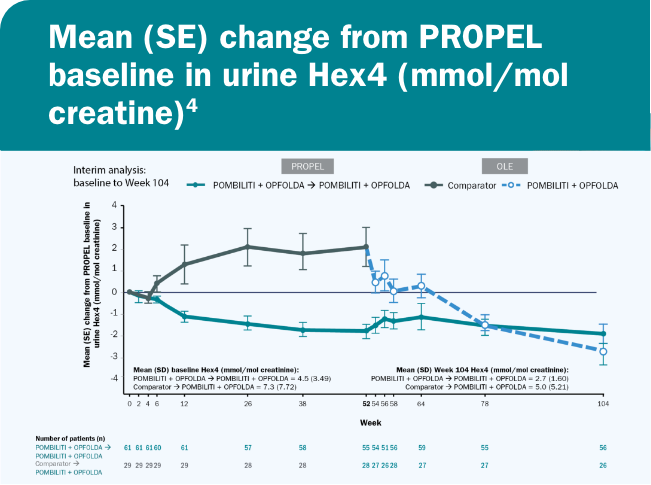
Elevated Hex4 levels are indicative of Pompe disease.7

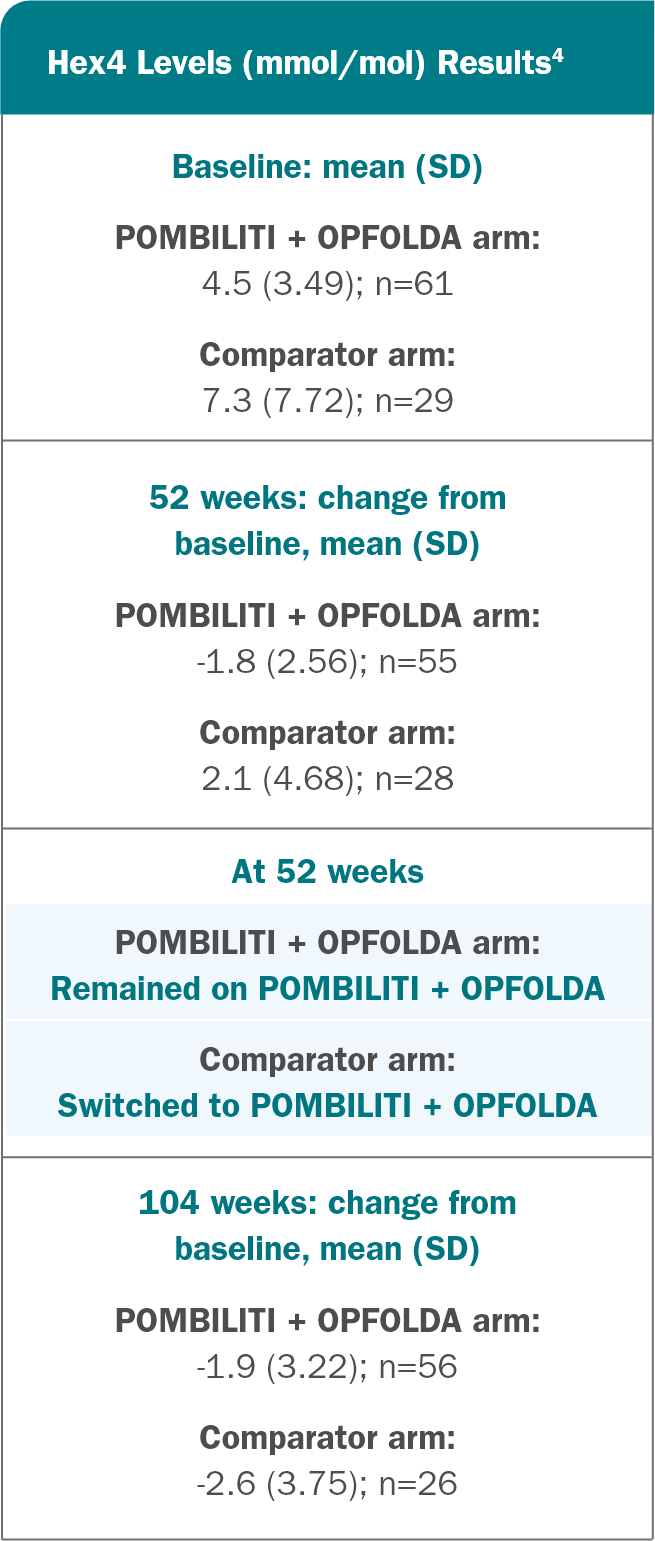
ERT-subgroup analysis: prespecified from PROPEL
Biomarker: Serum Creatine Kinase (CK) Levels
CK is a biomarker for muscle damage6

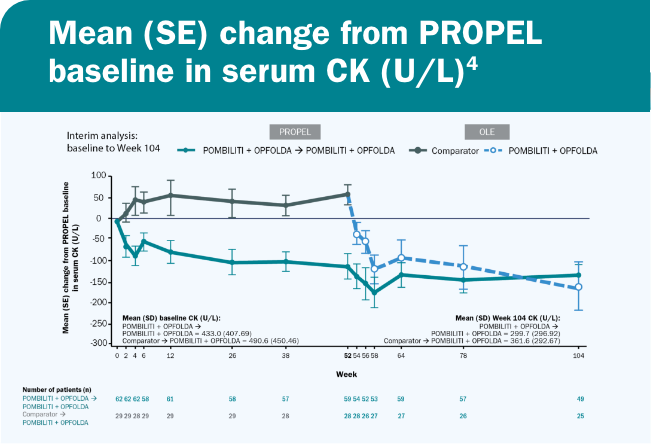

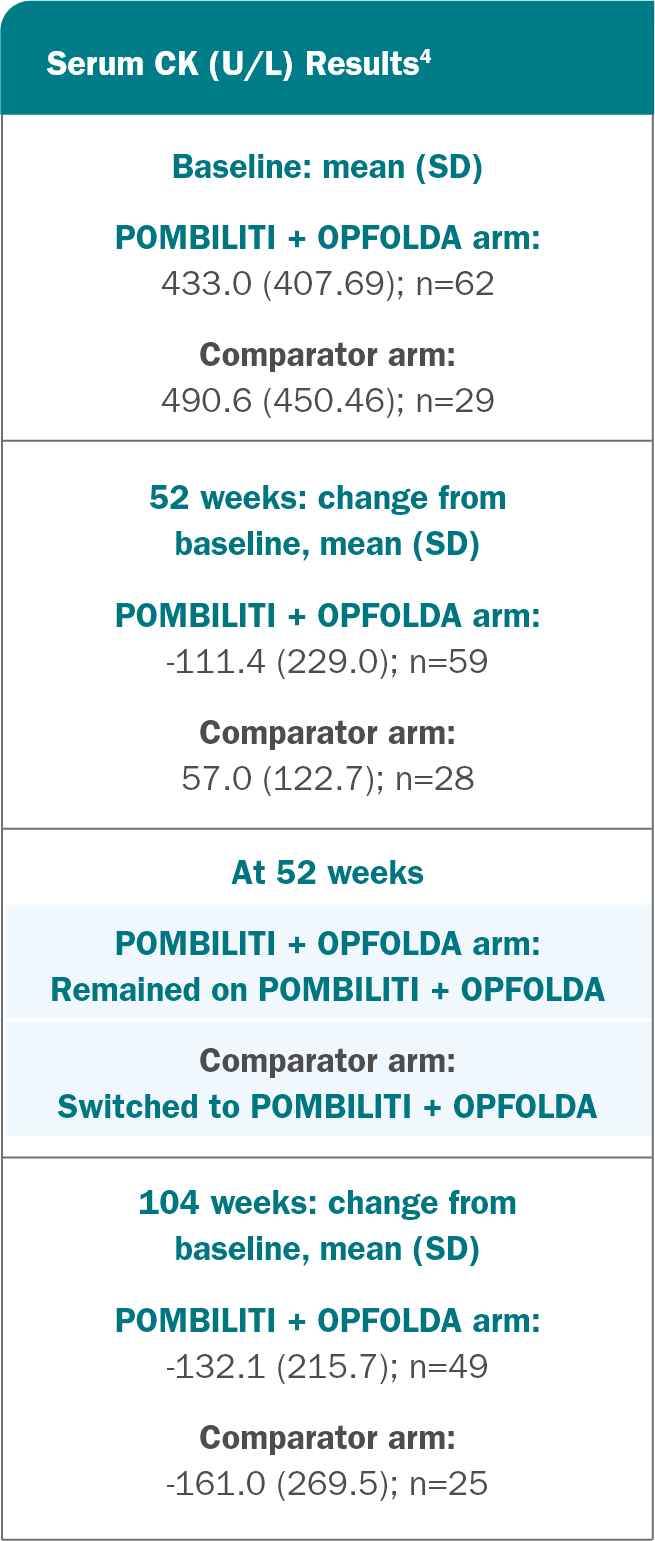
 ERT-subgroup analysis: prespecified from PROPEL
ERT-subgroup analysis: prespecified from PROPEL
6-Minute Walk Distance (6MWD) Results4
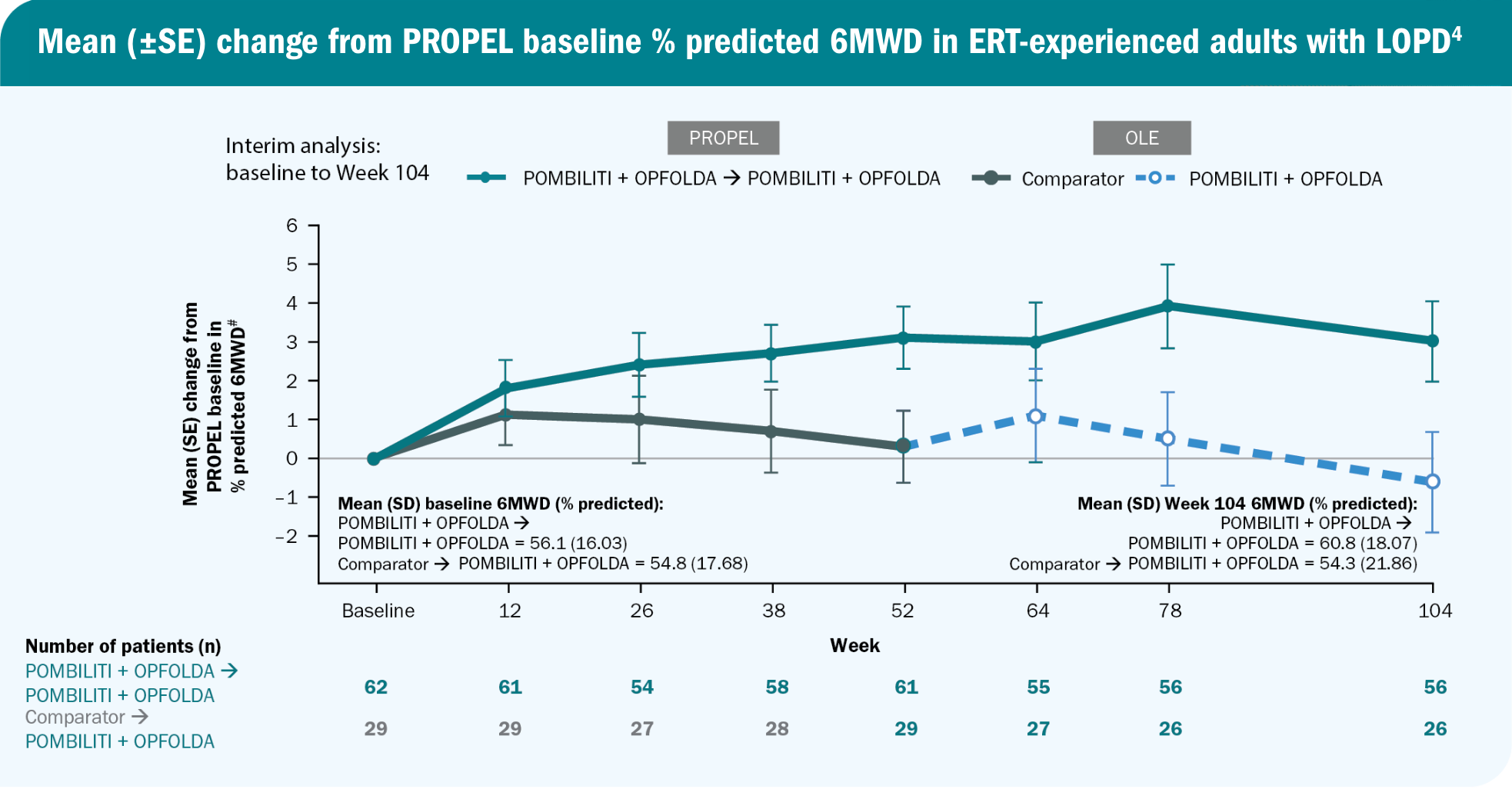
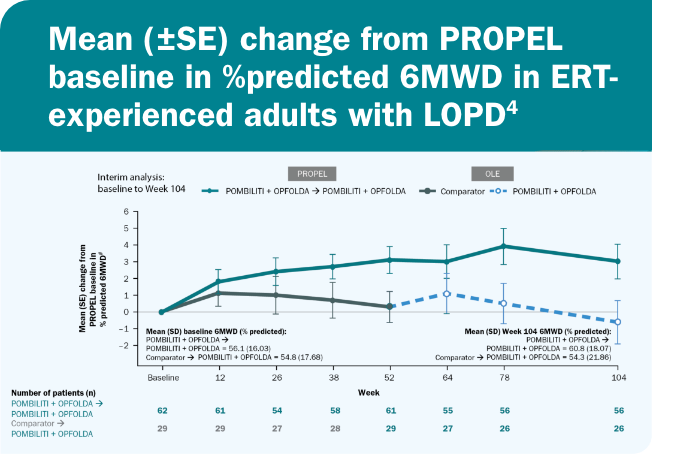
#Primary endpoint for superiority was not met.4

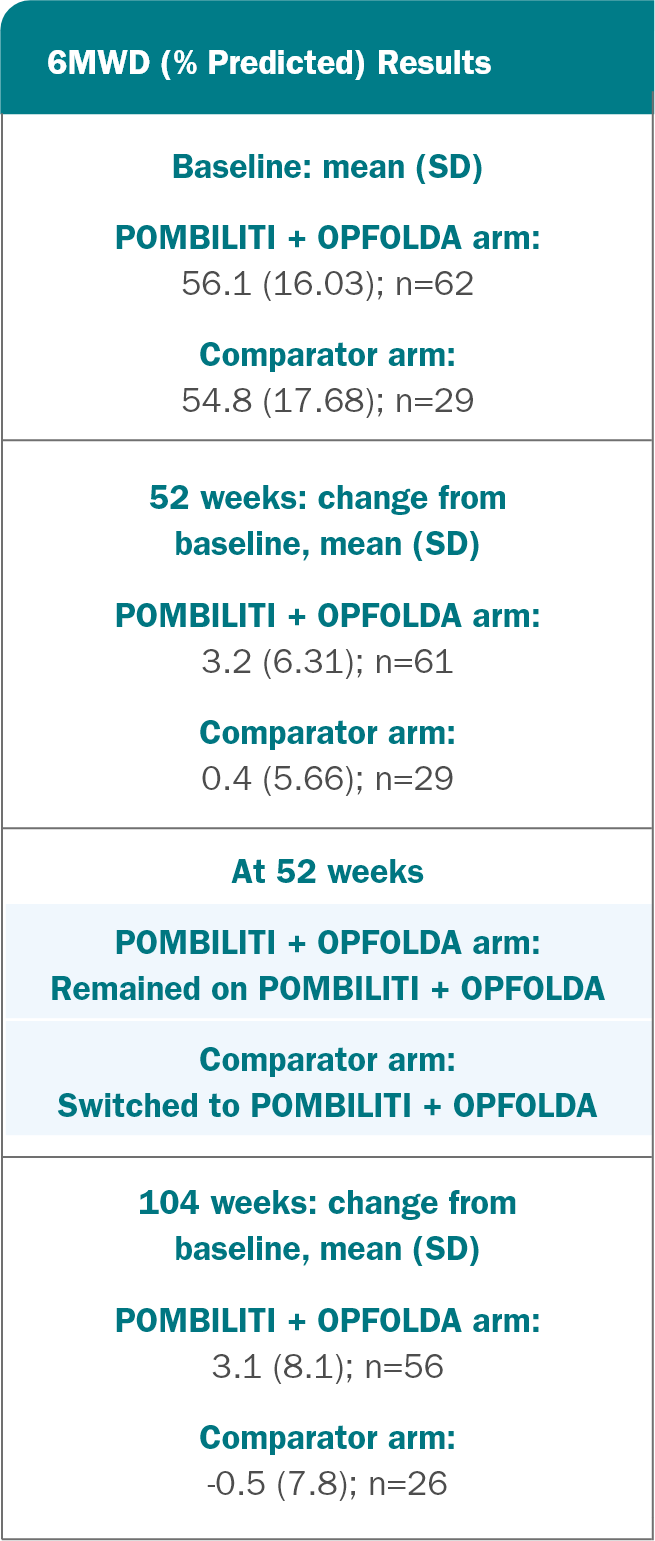
 ERT-subgroup analysis: prespecified from PROPEL
ERT-subgroup analysis: prespecified from PROPEL
Percent-predicted (PP) Forced Vital Capacity (FVC) Results4
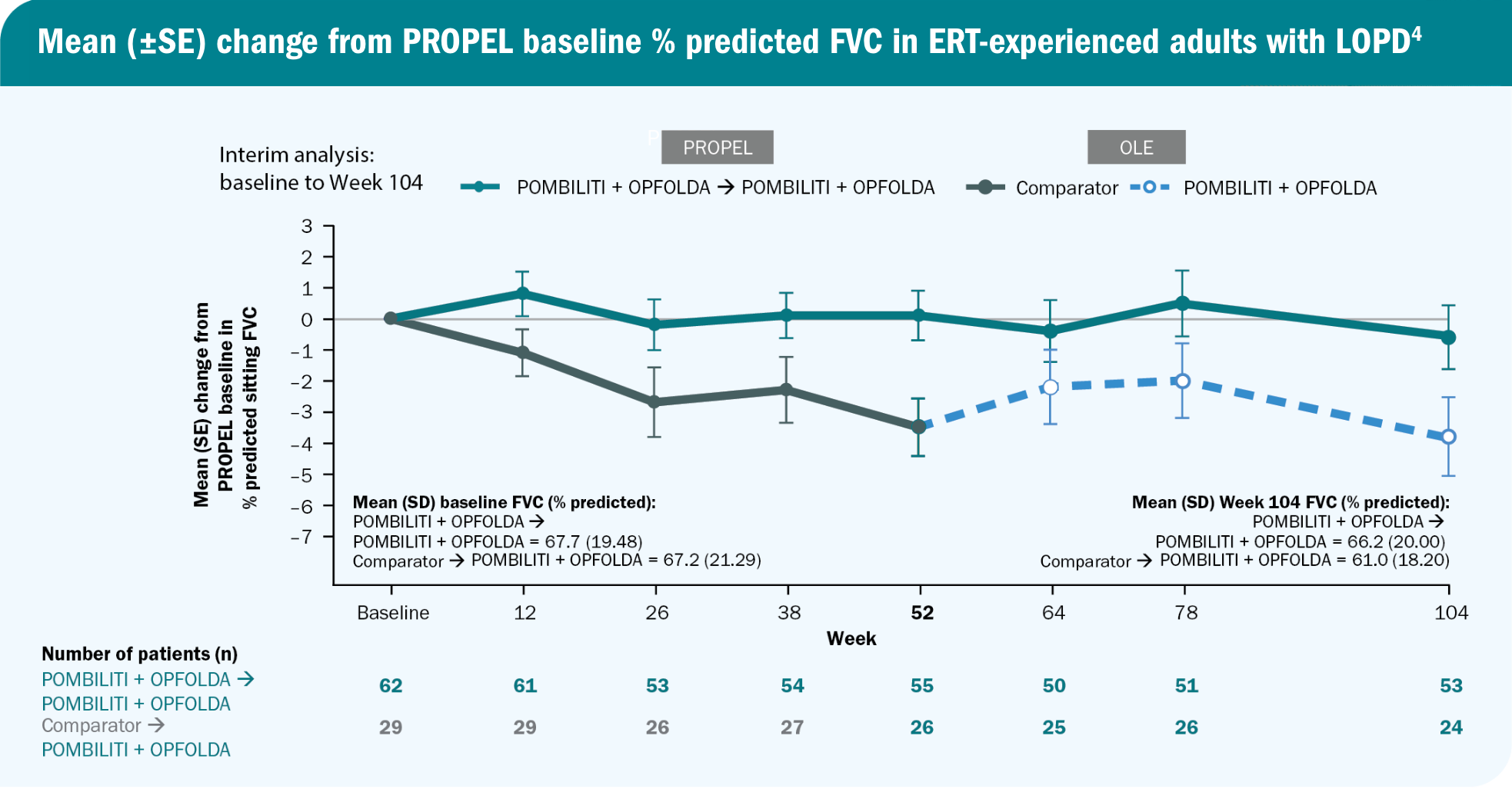
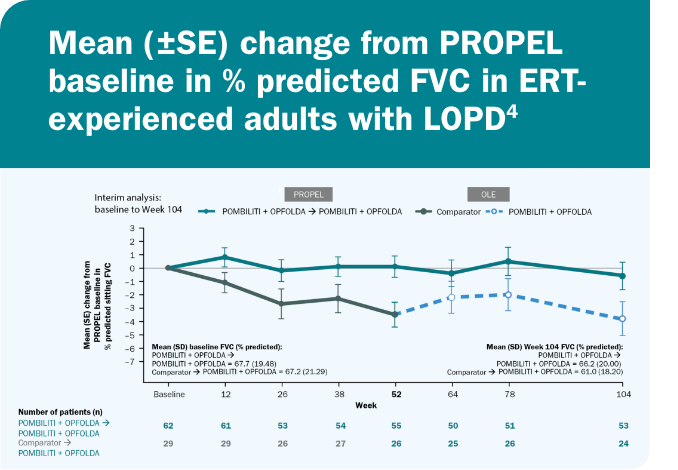

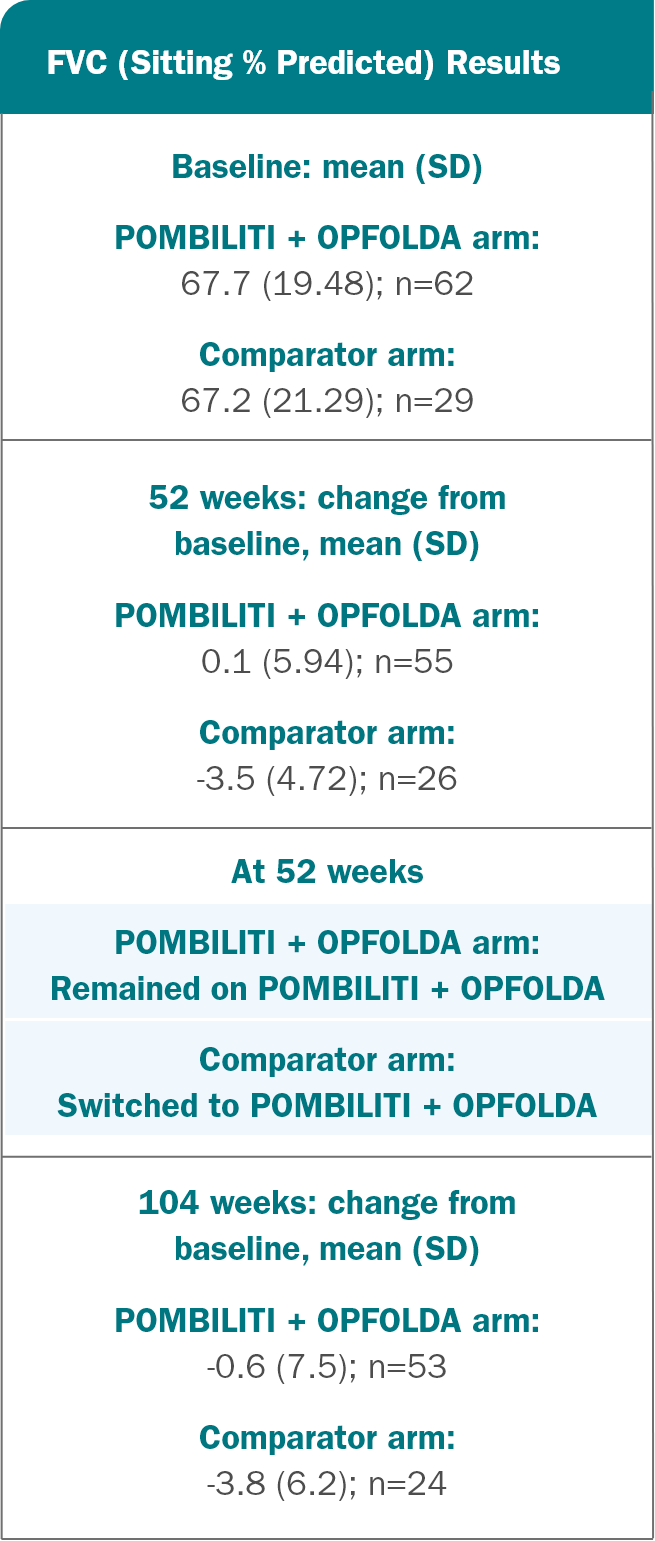
OLE: Safety Profile Through 104 Weeks
No New Safety Signals Were Identified During the OLE4
- Most TEAEs were mild to moderate in severity
- The most common TEAEs were headache, diarrhea, pyrexia, fatigue, and nausea
- Five patients withdrew from the study due to TEAEs experienced during the OLE
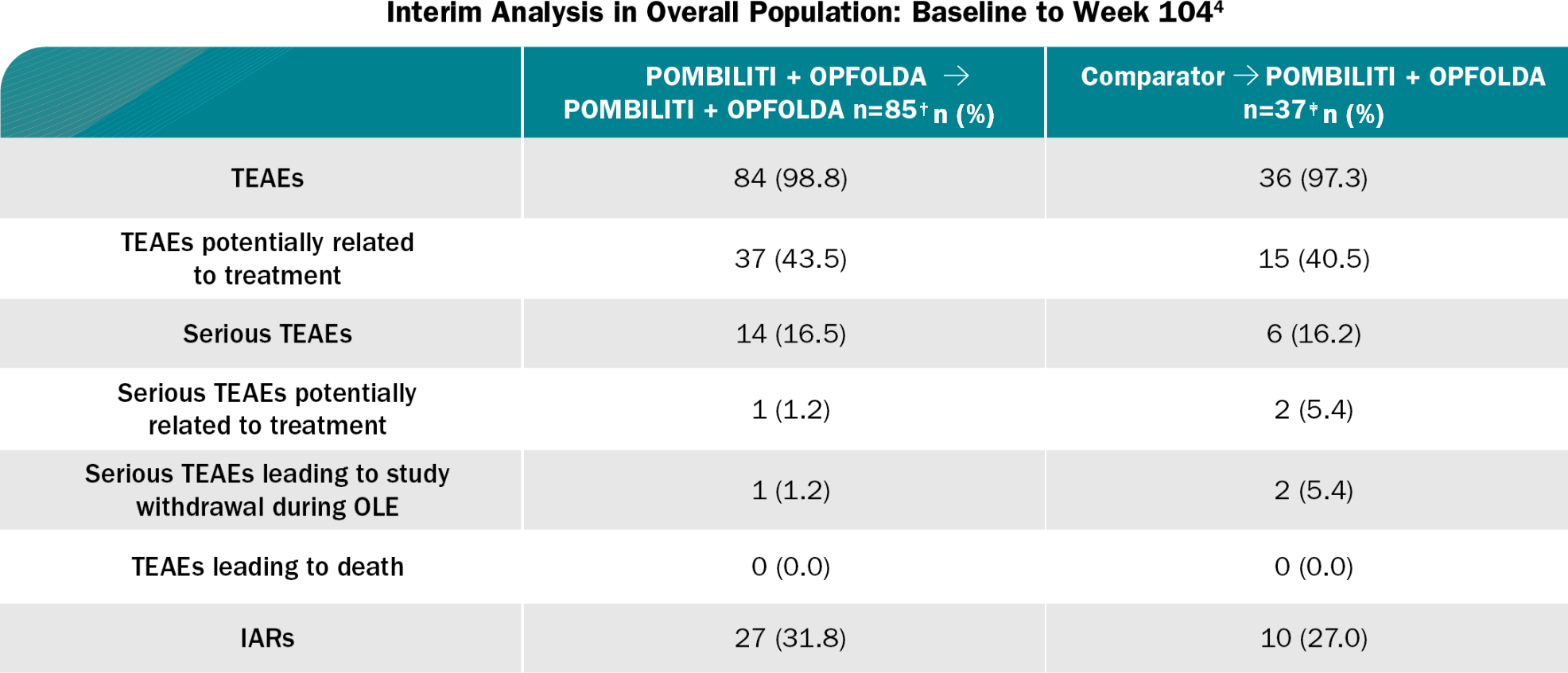
IARs, infusion-associated reactions; TEAEs, treatment-emergent adverse events.
†Includes data from patients treated with POMBILITI + OPFOLDA in
PROPEL who may or may not have continued
POMBILITI + OPFOLDA in the OLE, including data from both PROPEL and the OLE.4
‡Includes data from the OLE only.4
PROPEL: Safety Profile at 52 Weeks
Demonstrated Safety in 151 Patients Across 3 Clinical Trials1,2


A total of 5 patients across 3 clinical trials PERMANENTLY DISCONTINUED POMBILITI + OPFOLDA due to adverse reactions (4/5 due to serious adverse reactions)1
Life-threatening hypersensitivity reactions, including anaphylaxis, have been reported in POMBILITI-treated patients1
- In clinical trials, 41 (27%) POMBILITI-treated patients experienced hypersensitivity reactions, including 4 (3%) reporting severe hypersensitivity reactions and 4 (3%) additional patients who experienced anaphylaxis1*
- Infusion-associated reactions were reported in 48 (32%) patients treated with POMBILITI + OPFOLDA across three clinical trials1
- There was no identified clinically significant effect of ADA on POMBILITI + OPFOLDA PK or PD over the treatment duration of 52 weeks in PROPEL. Due to the small number of patients with negative ADA, the effect of ADA on the effectiveness of POMBILITI + OPFOLDA is unknown1
ADA, antidrug antibodies; PD, pharmacodynamics; PK, pharmacokinetics.
*Fulfilling at least one of the Sampson criteria.1
OLE: Safety Profile Through 104 Weeks
No New Safety Signals Were Identified During the OLE4
- Most TEAEs were mild to moderate in severity
- The most common TEAEs were headache, diarrhea, pyrexia, fatigue, and nausea
- Five patients withdrew from the study due to TEAEs experienced during the OLE
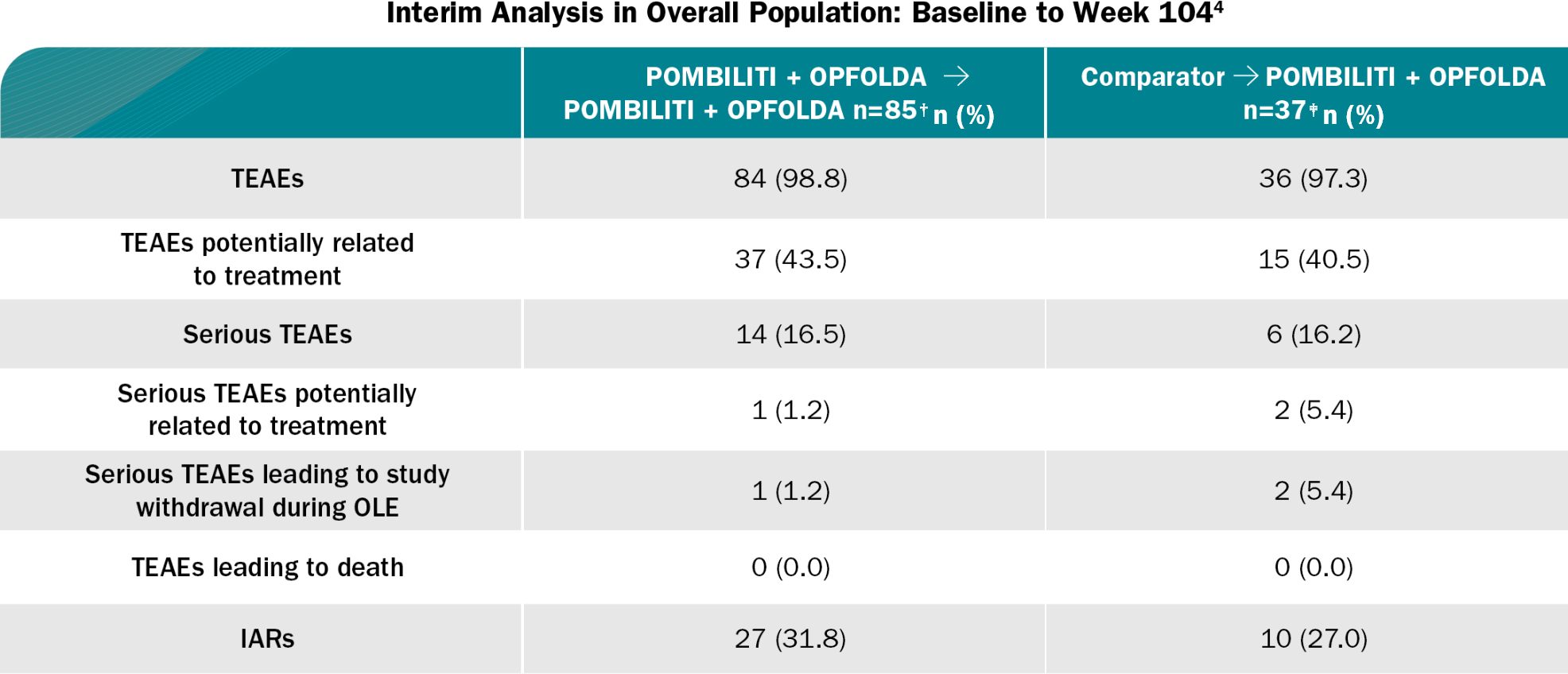
IARs, infusion-associated reactions; TEAEs, treatment-emergent adverse events.
†Includes data from patients treated with POMBILITI + OPFOLDA in PROPEL who may or may not have continued
POMBILITI + OPFOLDA in the OLE, including data from both PROPEL and the OLE.4
‡Includes data from the OLE only.4
Click to see additional Important Safety Information, including BOXED WARNING.
See dosing and administration